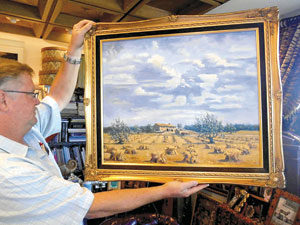
This week TT came into the office with a nice oil painting signed A.G. Deacon. This oil on canvas landscape, a view of a French vineyard, came with memories, as many works of art do. At age 22, back in 1976, TT roamed through Britain on a shoestring. He found cheap quarters near Hyde Park and signed up for a roommate to save money. His roommate, a British painter, sold at a market stall in Hyde Park. Allan G. Deacon painted fakes and frauds of famous paintings. A.G. bragged about his ability to forge anyone’s brush strokes. TT counseled A.G. to watch out; forging paintings is a risky business. A.G. had quite a nice canvas hanging in their shared room. TT bought the painting for $350. That’s the painting TT brought in for me to see.
Allan was a lady’s man with an athletic movie-star build. Research revealed that A.G. had been an RAF’s Sergeant flying a plane which crashed into the sea off the Mull of Kintyre. A.G. survived. This makes chronological sense. In 1940, many young Britons became soldiers, at the age of 17. TT describers A.G. as a good looking middle-aged man in 1976, so previous to becoming an artist, A.G. served as an adrenaline-fueled pilot.
TT’s letters received from A.G. years afterwards had different spellings of A.G.’s name(s)! Not surprisingly, eventually A.G. ended up in jail for art forgery. This explains the difficulty to find any sale’s records for paintings by A.G. Deacon. This reminds me of Rudyard Kipling quoting the Devil in his poem The Conundrum of the Workshops, “You did it, but was it art?”
Two famous British art forgery cases
The first story involves a cult group in the mid 19th century, the Transformationalists, bent on transforming the world through all of the arts. They believed that the arts should have no authorship since everyone is an artist. A great forger emerged from this circle, Malcolm Bingham. An art collector gunned him down in 1904. That violent act perhaps reveals his devious talent. He ran the market!
The second more recent but equally remarkable story involves a 20th century master scam, the most damaging art con of the century, the case of the genius forger, John Myatt. Myatt was sentenced to prison in England in the mid 1990’s, but before that, he forged Chagall, Braque, Dubuffet, Matisse, Giacometti, Ben Nicholson and Le Corbusier from his little cottage outside of London. Myatt painted 200 forgeries in the styles of nine modern masters, delivering one painting every six weeks to the mastermind marketer John Drewe, his accomplice. Drewe consigned these 200 works to Christie’s, Sotheby’s and Phillips, as well as to reputable dealers in London, Paris and New York. Myatt earned over $165,000 over the years, stashed in a Swiss bank account.
Drewe “authenticated” Myatt’s work via bogus provenances he created. Drewe attained access to the tightest security art archives in the world, establishing a chain of ownership and histories of the works, along with stolen “official” authenticating seals. Of the 200 “masterworks” by Myatt sold into the market by Drewe, only 73 have been recovered or located. The rest are still out there, all 127 fakes. Drewe capitalized on the art world’s reliance on “provenance,” the art world’s method of validation. Between Myatt and Drewe, Myatt knew how to paint and Drewe know how to manipulate the system.
A parallel to TT’s forger, A.G. Deacon
Forgers like Deacon, Drewe and Myatt create fiction throughout a lifetime, gathering many names and professions. Drewe, for example, was born John Cockett; at any given point he was a PhD Professor of Physics, a descendant of the Earl of York, in the Ministry of Defense, or associated with British Intelligence. Myatt was a down-on-his-luck, recently divorced art teacher who needed money. Peter Landesman, who covers forgeries in the art world, wrote “perhaps no better forger of his or any other time has worked so prodigiously and in so many styles.”
This begs the question – are our museums’ collections all genuine? Thomas Hoving, former director of the Metropolitan Museum of Art, said that during his tenure, a full 40% of the artworks considered for purchase by the museum were phony or over-restored. Artists aren’t blameless. Salvador Dali, on his deathbed, signed thousands of sheets of blank paper for future fake etchings and lithographs.
Fraudsters will always be fraudsters in any century, as long as art costs what the market gets for great artists’ works.
An example
When I applied to do research at the Victoria and Albert National Art Library, they required a scholarly reference letter. John Drewe, I learned, also researched at the library. When Drewe made his application, he stated his occupation as Professor of Physics. He gave as his reference a Dr. John Cockett (his alias) at his address. When the Library wrote to that address, Drewe wrote back, “John Drewe is a man of integrity,” and signed it Dr. John Cockett.
So, TT, your painting is worth a great story, and perhaps $500 more.
Hello.
In 1970 my parents bought a painting depicting small boats pulled onto the beach, in the background some rocks, the sea and land on the other side of the Bay. It is signed A G DEACON 1970. Does your friend TT recall such a painting? May have been painted in Spain, we did visit Spain every summer when I was a little girl. I have found one other painting with the same signature of a Spanish scene. Do you think my painting is worth taking to Christies?